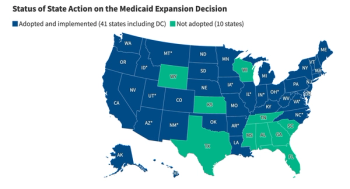
More primary care physicians turning away Medicaid patients
Medicaid populations might soon be facing additional problems in accessing care
NATIONAL REPORTS - Medicaid populations might soon be facing additional problems in accessing care, industry experts say, as more physicians turn down new patients.
According to a recent survey released by Jackson Healthcare, a staffing company based in Atlanta, an increasing number of physicians say they cannot afford to see Medicare and Medicaid patients. Survey results showed that 26% of physicians currently don't see Medicare and Medicaid patients, and 36% say they are no longer accepting new patients.
Among those who are the least likely to see new patients, 45% are family practitioners-an increase over previous surveys. It's particularly concerning for Medicaid populations, which are positioned to rise in number quickly.
Some large provider organizations stopped accepting certain government-program patients years ago, including the Mayo Clinic, Jackson says. Likewise, many states have cut reimbursement to Medicaid as a means to control costs.
Fortunately, there are major policy changes happening now that are outlining solutions to the problem, such as increased payment for primary care physicians who accept low-income patients.
"The federal government certainly sees payment as a big problem, which is why they put the money into the Patient Protection and Affordable Care Act," says Margaret A. Murray, CEO of the Association for Community Affiliated Plans (ACAP). "We're supportive of it and anticipate that many of our plans will be increasing the rates up to the Medicare level."
Another solution is the movement of beneficiaries into managed care. Many states initially shifted Medicaid members into managed care because of the access problems, which are often tied to payment rates. Although managed care doesn't have the access problem fully under control, Murray says, it's certainly better than fee for service.
According to a survey by the California Healthcare Foundation (CHCF), nearly a quarter of Medi-Cal recipients reported having difficulty finding a primary care provider who accepted their insurance. It also found the enrollees in managed care had slightly less difficulty finding specialists (30%) than those in fee for service (35%).
Because of a weak economy and growing enrollments in entitlement programs, states are under a great deal of pressure to stretch their budgets. State spending on Medicaid increased 20.4% in fiscal 2012, according to Reuters. In many cases, states have had to cut payments to managed care plans, including some safety net plans. Some have opted to absorb the rate cuts rather than pass them on to providers, which is only a short-term solution.
"That's a level of flexibility that may not be found in the fee-for-service world," says ACAP chief communication director Jeff Van Ness.
According to Murray, private health plans participating in Medicaid are held to a higher standard of network adequacy than the states' own fee-for-service programs, so managed care often provides more choices for enrollees. For example, Murray says, ACAP plans are required to have networks of certain sizes and monitor them closely by using network software, secret shoppers, and a staff whose sole job is to make sure the networks are adequate and available.
Another way to combat the access problem is by making sure that networks are robust. For instance, CareOregon, a managed care Medicaid plan in Portland, opened its own clinics in areas that lacked network adequacy. Similarly, L.A. Care and San Francisco Health Plan have started offering e-consults, which allow primary care providers to talk to specialists on secure Web-based portals to increase access to specialists via primary care.
Jackson says there would be a dramatic cost improvement if more healthcare professionals were paid for telephonic medicine.
"Instead the focus can be on giving more cost-effective healthcare and creating better incentives that will reduce the overall cost," Jackson says. "When you reduce the cost, it increases access for everybody, period."
Physicians least likely to see Medicaid patients
Newsletter
Get the latest industry news, event updates, and more from Managed healthcare Executive.





















































